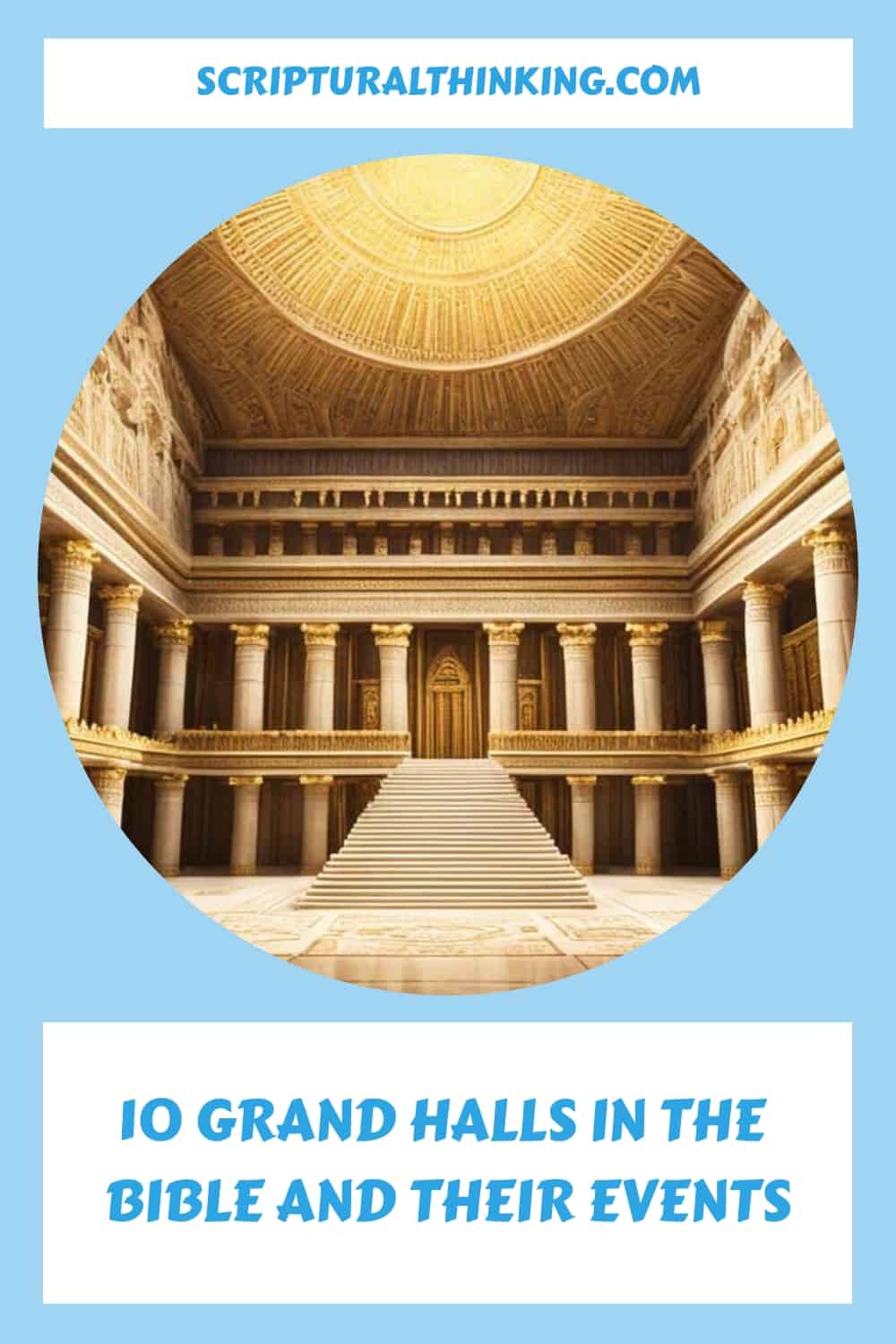Table of Contents
Have you ever wondered what it would be like to step inside the grand halls of the Bible? To witness the awe-inspiring events that unfolded within their majestic walls? From extravagant temples to opulent palaces, these grand halls were the stage for some of the most significant moments in biblical history. Join us as we embark on a journey through time and explore the iconic grand halls in the Bible where history and faith converge in unforgettable encounters.
Prepare to be amazed as we uncover the captivating stories behind Solomon’s Temple in Jerusalem, where worship and celebrations reached new heights. Discover Pharaoh’s Palace in Egypt, a place where dreams were decoded and destiny unfolded. Unravel the mystery of the Hall of Babylon’s King Nebuchadnezzar and the enigmatic writing on the wall. Delve into the gripping tale of Esther’s banquet, where a queen’s bravery saved an entire people.
And that’s just the beginning. Join us as we take you on a fascinating journey through the grand halls of the Bible, where miracles happened, prophecies were revealed, and lives were forever changed. Get ready to explore the places where faith meets history and discover the remarkable events that unfolded within these hallowed halls. Are you ready to step inside?
Solomon’s Temple in Jerusalem – The Ultimate Party Place for Prayers
King Solomon’s Temple in Jerusalem was a magnificent structure that served as the epitome of worship and religious events in Israel. It was a place where people came to connect with the divine, offer sacrifices, and celebrate festivals in grandeur.
Imagine stepping into this awe-inspiring temple, adorned with gold, shimmering from every corner. The intricate craftsmanship and sheer opulence created an atmosphere befitting of God’s presence. It was like entering the VIP lounge of a heavenly party.
This temple wasn’t just a place for individual prayer; it was the heart of worship for the entire nation. People gathered here to come together as a community, to seek guidance, and to honor God through song, dance, and rituals. It was a vibrant hub of spiritual activity.
The sheer grandeur of Solomon’s Temple elevated religious events to a whole new level. It was a place where people celebrated important festivals, such as Passover and Sukkot, with unmatched splendor and devotion.
Worship at Solomon’s Temple was not limited to the Israelites alone. Visitors from far and wide flocked to this sacred space, recognizing its significance and the divine presence it housed. It was a testament to the temple’s prominence and the profound impact it had on all who experienced it.
Significance of Solomon’s Temple
The construction of Solomon’s Temple marked a pivotal moment in Israel’s history. It symbolized the establishment of a permanent dwelling place for God among His people. The temple served as a central pillar of religious life and a testament to the faith and dedication of the Israelites.
Moreover, Solomon’s Temple became the architectural inspiration for subsequent religious structures, influencing the design and layout of many other temples and places of worship.
| Key Features of Solomon’s Temple | Description |
|---|---|
| The Holy of Holies | The innermost chamber where the Ark of the Covenant was placed, representing the very presence of God. |
| The Bronze Sea | A massive basin filled with water for various purification rituals. |
| The Pillars | The twin pillars, Jachin and Boaz, that stood prominently at the entrance of the temple. |
| The Court of the Priests | An area where priests performed rituals and offered sacrifices. |
Overall, Solomon’s Temple in Jerusalem held immense cultural, historical, and spiritual significance. Its captivating beauty and divine aura made it a place where worship transcended earthly boundaries, connecting humanity to the divine presence.
In the next section, we will explore another iconic grand hall in the Bible – Pharaoh’s Palace in Egypt, where dreams were decoded and destiny unfolded. Stay tuned for more biblical encounters and captivating events.
References:
- Harrison, R. K. (2003). Solomon’s Temple: Myth and History. World Archaeology, 34(3), 313-334.
- Grabbe, L. L. (1995). Solomon’s Temple and Its Function. Biblical Archaeologist, 58(3), 150-163.
Pharaoh’s Palace in Egypt – Where Dreams Got Decoded
Remember Joseph? The guy with the amazing technicolor dreamcoat? He ended up in Pharaoh’s Grand Hall, explaining Pharaoh’s weird dreams about skinny cows eating fat cows. This place was like the ancient version of a mystery-solving club, where Joseph went from prisoner to Egypt’s top advisor.
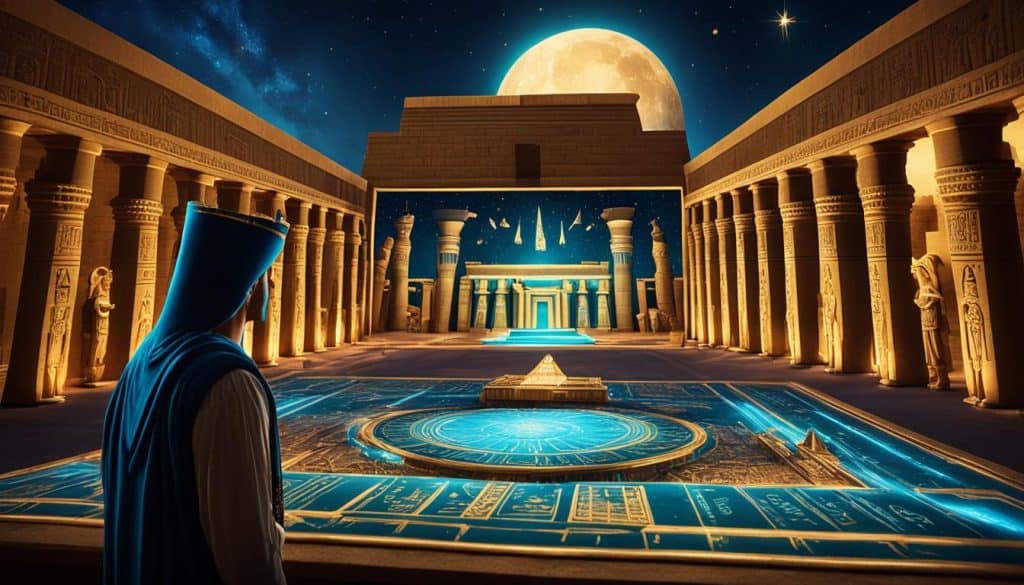
Joseph: From Prisoner to Dream Interpreter
Joseph’s journey in Egypt took a remarkable turn when he stepped into the prestigious halls of Pharaoh’s Palace. As a captive turned interpreter, he unraveled the enigmatic dreams that troubled Pharaoh, showcasing his exceptional ability to decipher the divine messages woven within these perplexing visions.
And Pharaoh said unto Joseph, I have dreamed a dream, and there is none that can interpret it: and I have heard say of thee, that thou canst understand a dream to interpret it. – Genesis 41:15
Joseph’s profound insight into dreams and his wisdom in providing solutions elevated him to a position of authority and admiration within Egypt’s royal court. The Grand Hall of Pharaoh’s Palace became a beacon of hope and revelation as Joseph skillfully navigated the world of dream interpretation.
The Dream Interpretation Club
The corridors of Pharaoh’s Palace echoed with intrigue and mystery as Joseph, a member of the ancient dream interpretation club, unraveled the secrets of dreams. His contributions to unraveling symbolism and predicting future events earned him the trust and respect of Pharaoh, solidifying his role as Egypt’s prime minister.
By tapping into the divine wisdom granted to him, Joseph provided valuable guidance during a time of crisis, enabling Pharaoh to navigate famine and ensure the prosperity and survival of the Egyptian empire.
Journey into the Palace
Stepping inside the opulent Pharaoh’s Palace was like entering a world of grandeur, power, and intricacy. Vibrant tapestries lined the walls, and golden columns soared upwards, reflecting the greatness of the Pharaoh and the significance of the hall.
The Grand Hall, where Joseph shared his interpretations, stood as the centerpiece of the palace. Here, amidst the splendor and majesty, Joseph transformed from a mere prisoner to Egypt’s esteemed dream interpreter, leaving an indelible mark on ancient history.
| Joseph’s Contribution | Impact |
|---|---|
| Interpreting dreams | Provided crucial guidance during times of uncertainty |
| Wisdom and insight | Earned the trust and respect of Pharaoh |
| Position as prime minister | Brought stability and prosperity to Egypt |
The Hall of Babylon’s King Nebuchadnezzar – The Writing’s on the Wall
In the heart of Babylon stood the majestic Hall of King Nebuchadnezzar, where history and mystery intertwined. This grand hall was not just a symbol of power and opulence; it was also the setting for one of the most intriguing and ominous events in ancient times. Legend has it that during a lavish feast hosted by King Belshazzar, the son of Nebuchadnezzar, a chilling spectacle unfolded that left the entire kingdom in awe and fear.
The extravagant banquet was held amidst the splendor of the magnificent Hall of Babylon. The air was filled with the scent of exotic delicacies, the sound of laughter, and the clinking of stolen cups from Solomon’s Temple. It was a wild party that would soon take a spine-chilling turn.
As the festivities reached a fever pitch, a mysterious hand appeared, seemingly out of thin air, and began writing words on the wall. The partygoers were frozen in place, their laughter turned into hushed whispers of terror. It was as if an invisible presence had cast a spell on the jubilant crowd, demanding their attention.
“MENE, MENE, TEKEL, UPHARSIN.”
The writing on the wall baffled everyone present, leaving King Belshazzar in a state of confusion and despair. Desperate for answers, he summoned the wise man Daniel, known for his ability to interpret dreams and unravel mysteries.
As the anticipation grew, Daniel stepped forward and began deciphering the cryptic message. The words were a divine warning, a proclamation of judgment against Belshazzar and his kingdom. The chilling translation delivered by Daniel revealed the imminent downfall of the king and the end of his reign.
With these prophetic words, the once jubilant feast turned into a somber affair. The Hall of Babylon, once filled with revelry and excess, was now cloaked in darkness and uncertainty.
The mysterious writing on the wall of the Hall of Babylon serves as a timeless reminder of the fragility of power and the consequences of heedless extravagance. It was a wake-up call, a message intended to make King Belshazzar and the world around him reflect on their actions.
The Symbolism of the Writing
The words “Mene, Mene, Tekel, Upharsin” carried profound symbolism. “Mene” meant that God had numbered the days of Belshazzar’s reign and brought it to an end. “Tekel” signified that the king had been weighed and found wanting, lacking in moral integrity. “Upharsin” meant that Belshazzar’s kingdom would be divided and given to the Medes and Persians.
Reflections on the Writing’s Meaning
This mysterious occurrence carries an enduring message for us today. It urges us to reflect on the consequences of our actions, reminding us that power and wealth are fleeting. It serves as a reminder to always stay humble, and to seek wisdom and righteousness. The writing on the wall teaches us that there are greater forces at play, and our actions have consequences that extend beyond our immediate surroundings.
| Symbol | Meaning |
|---|---|
| Mene | God has numbered your days, bringing an end to your reign |
| Tekel | You have been weighed and found wanting |
| Upharsin | Your kingdom will be divided and given to others |
Esther’s Banquet – Where a Queen Saved Her People
In the heart of King Xerxes’ Grand Hall, Queen Esther hosted two banquets that would change the course of history. Picture a lavish setting adorned with opulent Persian luxury, as the finest dishes were served and laughter filled the air.
But beyond the festivities, there was a heroic mission unfolding. Queen Esther, a Jewish woman, had discovered a sinister plot to annihilate her people. With great courage, she used the banquets as an opportunity to expose the villain behind this horrific plan.
As the banquet reached its climax, Queen Esther revealed the truth to King Xerxes, pleading for the salvation of her fellow Jewish people. In that moment, the Grand Hall became a stage for heroism, as Queen Esther’s courageous act saved an entire community from destruction.
Esther’s banquet symbolizes the extraordinary power of one person’s bravery and resolve, showing that even in the most opulent halls, true strength lies in the willingness to stand up for what is right. It serves as a reminder that heroes can emerge from unexpected places, changing the course of history and safeguarding the lives of their people.

The Resilience and Heroism of Queen Esther
“For if you remain silent at this time, relief and deliverance for the Jews will arise from another place, but you and your father’s family will perish. And who knows but that you have come to your royal position for such a time as this?” – Mordecai to Queen Esther (Esther 4:14)
Queen Esther’s story is a testament to the power of courage, resilience, and unwavering faith. She faced immense internal and external challenges but rose above them to save her people. Today, the tale of Esther’s banquet continues to inspire, reminding us that ordinary individuals can make extraordinary impacts when driven by purpose and unwavering determination.
The Significance of Queen Esther’s Banquet
The significance of Esther’s banquet reaches far beyond a mere gathering or royal feast. It encapsulates the pivotal moment in history when a single act of bravery changed the destiny of an entire people. The banquet served as the backdrop for Queen Esther to reveal her true identity, risking everything to ensure the survival of her fellow Jews.
This remarkable event underscores the resilience and strength of the Jewish people throughout history. It is a testament to the power of unity, faith, and the unwavering commitment to preserving their heritage. Esther’s banquet becomes not only a historical event but a symbol of hope and triumph over adversity.
| Key Themes | Significance |
|---|---|
| Heroism | Esther’s courage and selflessness inspire individuals to stand up against oppression and fight for what is right. |
| Identity | Esther’s revelation of her Jewish identity highlights the importance of embracing one’s heritage and preserving cultural identity. |
| Unity | The banquet represents the unity of the Jewish people and reminds us of the strength that lies within a connected community. |
| Faith | Esther’s unwavering faith in God’s guidance highlights the transformative power of spiritual beliefs in navigating challenging circumstances. |
The Upper Room in Jerusalem – Where the Last Supper Happened
Step into the serene ambiance of the Upper Room, located in the heart of Jerusalem. This humble, cozy space holds immense spiritual significance as it was the setting for one of the most pivotal moments in history – the Last Supper. As you enter, you can almost feel the weight of the emotions that filled the room that fateful night.
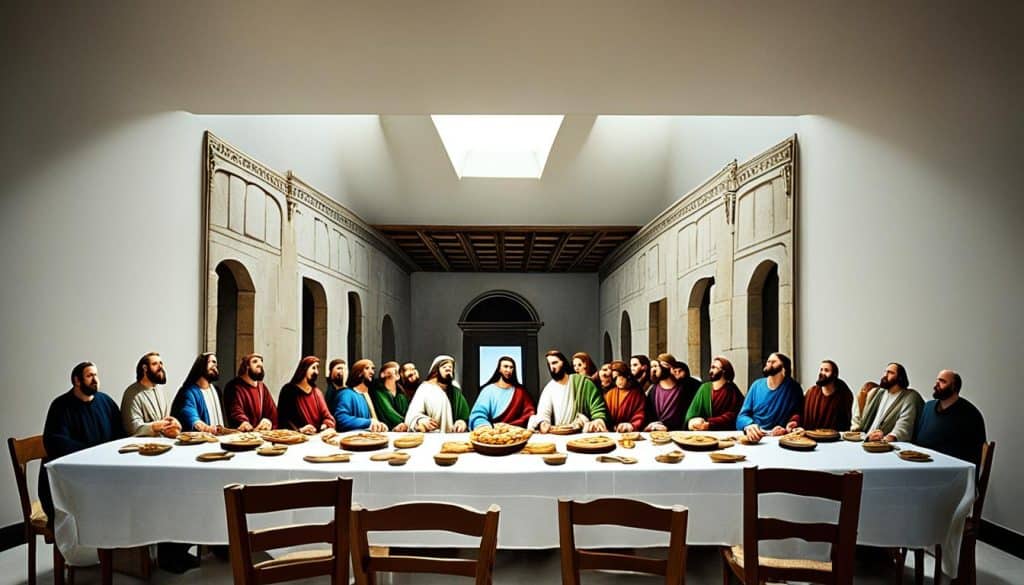
Jesus and his closest disciples gathered here for a bittersweet meal, knowing it would be their final time together before Jesus’ crucifixion. It was an intimate gathering, where they shared bread and wine, each morsel infused with deep meaning and symbolism. The Upper Room resonates with both joy and sorrow, as their conversations were filled with deep teachings and predictions of the events that were about to unfold.
“Take, eat; this is my body…”
“Drink from it, all of you; for this is my blood of the covenant…”
These profound words still echo in the hearts of believers today, an enduring reminder of sacrifice and redemption.
The Importance of the Last Supper
The Last Supper holds immense significance in Christianity, symbolizing the institution of the Holy Eucharist and showcasing Jesus’ selfless act of washing his disciples’ feet. It was during this special meal that Jesus revealed his impending betrayal and identified Judas as the one who would betray him.
Throughout history, countless works of art, literature, and music have been inspired by the Last Supper, forever immortalizing this sacred event. The Upper Room stands as a powerful testament to the enduring legacy of Jesus’ final gathering with his disciples.
| Key Symbolism | Meaning |
|---|---|
| Bread | Jesus’ body |
| Wine | Jesus’ blood |
| Foot Washing | Humility and servanthood |
| Promise of a new covenant | Eternal redemption and salvation |
The Upper Room serves as a sacred pilgrimage site for Christians worldwide, offering a tangible connection to the final moments Jesus spent with his disciples. Although the physical space may have changed over time, the spiritual significance and reverence associated with the Upper Room remain constant.
Visiting the Upper Room in Jerusalem allows one to step into history and experience a profound sense of spirituality. It is a place where the past converges with the present, inviting reflection, gratitude, and a deep appreciation for the ultimate sacrifice that unfolded within its walls.
Pilate’s Judgment Hall – Where Decisions Were Made
In the heart of Jerusalem stood Pilate’s Judgment Hall, a place that witnessed one of the most significant moments in human history. It was here that Jesus, the iconic figure of Christianity, was brought before Pontius Pilate, the Roman governor.
“I find no fault in this man,” Pilate proclaimed, recognizing Jesus’ innocence in the face of intense scrutiny and pressure from religious leaders.
This tense courtroom drama unfolded within the walls of Pilate’s Judgment Hall, where decisions had far-reaching consequences. Pontius Pilate found himself grappling with the weight of judgment, torn between political expediency and his own conscience.
Though Pilate ultimately succumbed to political pressure and allowed Jesus to be crucified, his actions serve as a reminder of the complexity of standing up for what is right in the face of opposition.
The Clash of Power and Conscience
The encounter between Jesus and Pontius Pilate in Pilate’s Judgment Hall speaks to the clash between power and conscience, highlighting the challenge of making difficult decisions.
While Pilate had the authority to spare Jesus’ life, he succumbed to political expediency, sacrificing justice for personal gain. In doing so, he symbolizes the timeless struggle between morality and self-interest.
The events that transpired within Pilate’s Judgment Hall sparked a chain of events that would have far-reaching consequences on both the religious and political landscapes of the time. Jesus’ crucifixion became a pivotal moment in Christian theology, representing sacrifice, redemption, and the ultimate act of divine love.
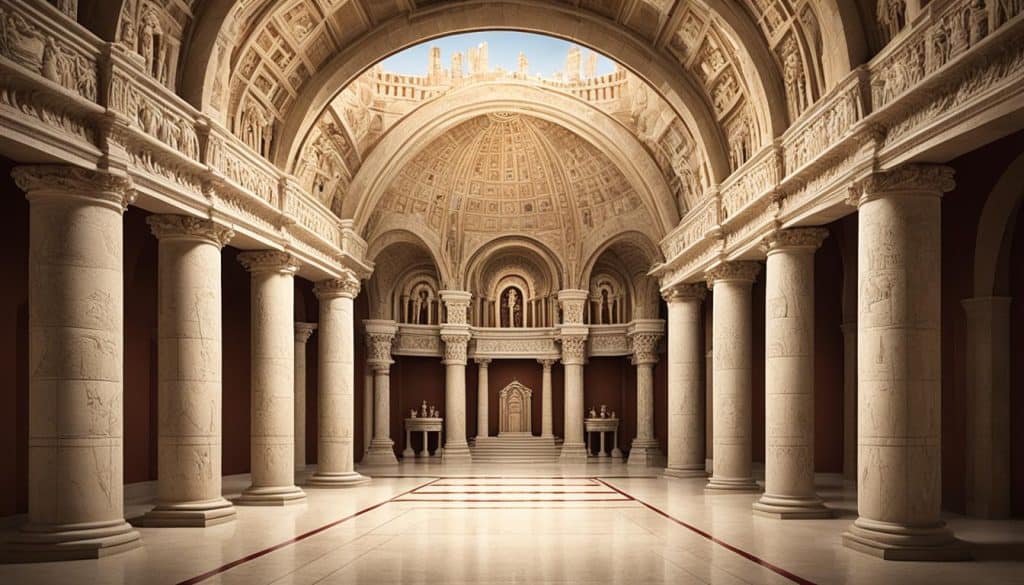
An Immutable Lesson in History
The story of Pilate’s Judgment Hall reminds us of the eternal struggle between upholding principles and succumbing to external influences. It serves as a cautionary tale, challenging us to reflect on the choices we make in our own lives.
Just as Pontius Pilate faced a pivotal moment of decision in Pilate’s Judgment Hall, each of us encounters similar choices in our daily lives. The legacy of this historic location invites us to consider the true measure of strength and integrity, urging us to stand firm in our convictions, even in the face of adversity.
The Tabernacle – The Traveling Tent of Wonders
Before Solomon’s Temple graced the city of Jerusalem, the Israelites had their own unique place of worship and divine encounters – the Tabernacle. This extraordinary mobile tent served as a sacred space where the Israelites could connect with God during their wanderings in the wilderness.
Constructed according to precise instructions given by God to Moses, the Tabernacle was a testament to the Israelites’ faith and devotion. It was a portable sanctuary, a symbol of their relationship with the divine.
At the heart of the Tabernacle was the Holy of Holies, a special chamber that housed the Ark of the Covenant. This sacred space was said to be the dwelling place of God’s presence, and only the High Priest could enter and communicate with the Almighty there. It was truly a place where the ordinary met the extraordinary, and divine encounters became a reality.
The Tabernacle played a vital role in the daily lives of the Israelites, serving as a focal point for their worship, sacrifices, and spiritual connection. It provided a tangible reminder of their covenant with God and their journey as a chosen people.
“And let them make me a sanctuary, that I may dwell among them.” – Exodus 25:8
Imagine the awe-inspiring sight of the Tabernacle as it was set up in various locations throughout the Israelites’ journey. Its colorful curtains, intricately crafted furnishings, and holy rituals created an atmosphere of reverence and wonder.
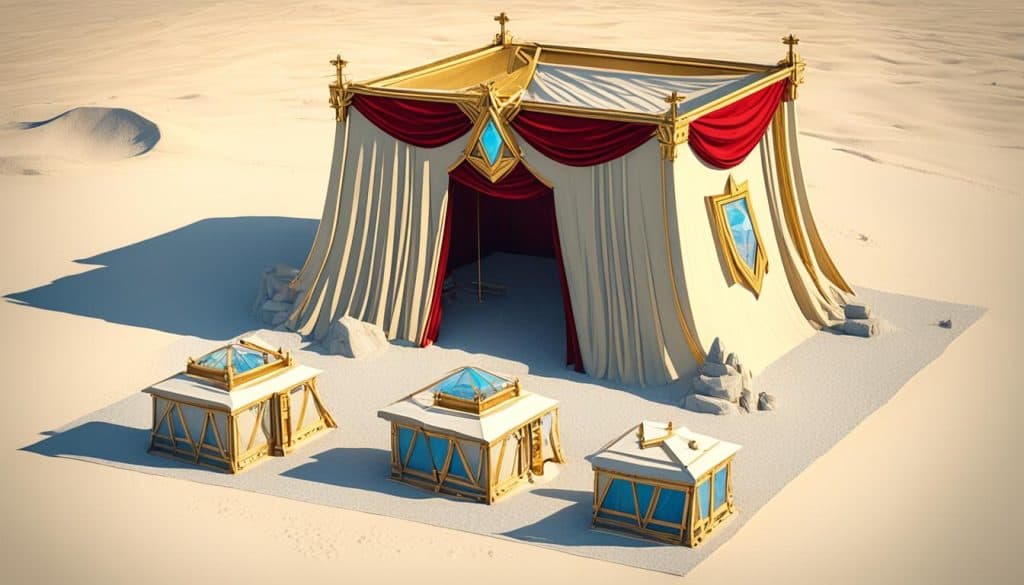
| Features of the Tabernacle | Description |
|---|---|
| The Outer Court | A spacious area enclosed by a curtain where the Israelites would gather for communal worship, burnt offerings, and fellowship. |
| The Holy Place | A sacred chamber accessible to the priests, containing the table of showbread, the golden lampstand, and the altar of incense. |
| The Holy of Holies | The innermost chamber, separated by a veil, where the Ark of the Covenant resided and where the divine presence dwelled. |
The Tabernacle was an extraordinary testament to the Israelites’ faith and their deep desire to commune with their Creator. It accompanied them on their journey and served as a constant reminder of God’s faithfulness and guidance.
Though the Tabernacle eventually gave way to the grandeur of Solomon’s Temple, its significance and spiritual impact on the Israelites cannot be understated. It represented both their physical and spiritual journey, encapsulating their divine encounters and the sacred bond between God and His chosen people.
The Legacy of the Tabernacle
The Tabernacle left an indelible mark on the Israelites’ culture and worship practices. It served as a model for future places of worship, including the magnificent Temple in Jerusalem. The concept of the Holy of Holies and the sacredness of God’s presence influenced the Hebrew people’s understanding of divine encounters.
Even today, the idea of a sacred space reserved for encountering the divine resonates with people of faith. Whether it be a temple, church, synagogue, or mosque, the legacy of the Tabernacle lives on, reminding believers of the awe-inspiring nature of divine encounters and the importance of setting aside dedicated places for spiritual connection.
Samson’s Final Stand – The Philistine Temple
In the grand hall of the Philistine Temple, history witnessed an awe-inspiring event – Samson’s final stand. A renowned strongman, Samson found himself in captivity, forced to entertain his enemies. Little did they know what he had in store.
With immense strength and unwavering determination, Samson pushed apart the two central pillars of the temple. The earth-shattering result was nothing short of heroic and tragic. The entire structure came crashing down on the Philistines and Samson himself, ending his life but delivering a powerful blow to his adversaries.
Samson’s final act in the Philistine Temple serves as a testament to his extraordinary physical prowess and unyielding dedication. It was a culmination of bravery and sacrifice, leaving an indelible mark in biblical history.
| Location | Event |
|---|---|
| Philistine Temple | Samson’s Final Stand |

Witnessing the incredible strength of Samson as he brought down the Philistine Temple is a reminder of the resilience and determination that can be found in the face of adversity. His story continues to inspire both believers and non-believers alike, showcasing the power of one individual’s unwavering commitment to a greater cause.
The Synagogue in Nazareth – Where Jesus Dropped the Mic
In the heart of Nazareth, a small town in Galilee, lies a humble yet significant place where Jesus left his mark. The Synagogue in Nazareth, a local meeting spot for the community, became the stage for a moment that would reverberate through history.
As Jesus stood before the crowd gathered in the Synagogue, he unfolded a scroll of the Prophet Isaiah. With conviction in his voice, he read the words that would ignite astonishment and controversy:
“The Spirit of the Lord is upon me because he has anointed me to proclaim good news to the poor. He has sent me to proclaim freedom for the prisoners and recovery of sight for the blind, to set the oppressed free, to proclaim the year of the Lord’s favor.” (Luke 4:18-19)
This powerful proclamation was Jesus declaring himself as the Messiah, the long-awaited Savior. The Synagogue in Nazareth became the witness to this pivotal moment in Jesus’ ministry, as he unveiled his purpose and mission.
The impact of Jesus’ words reverberated far beyond the walls of the Synagogue. The people in attendance were left in awe, marveling at the audacity and authority behind his claims. Yet, not everyone received his message with open arms. Jesus’ declaration stirred up controversy and created divided opinions among those who witnessed this momentous event.
Just like a mic-drop moment in modern times, Jesus’ announcement in the Synagogue echoed throughout history. His words ignited hope, sparked curiosity, and challenged the status quo. It was a proclamation that would shape destinies and transform lives.
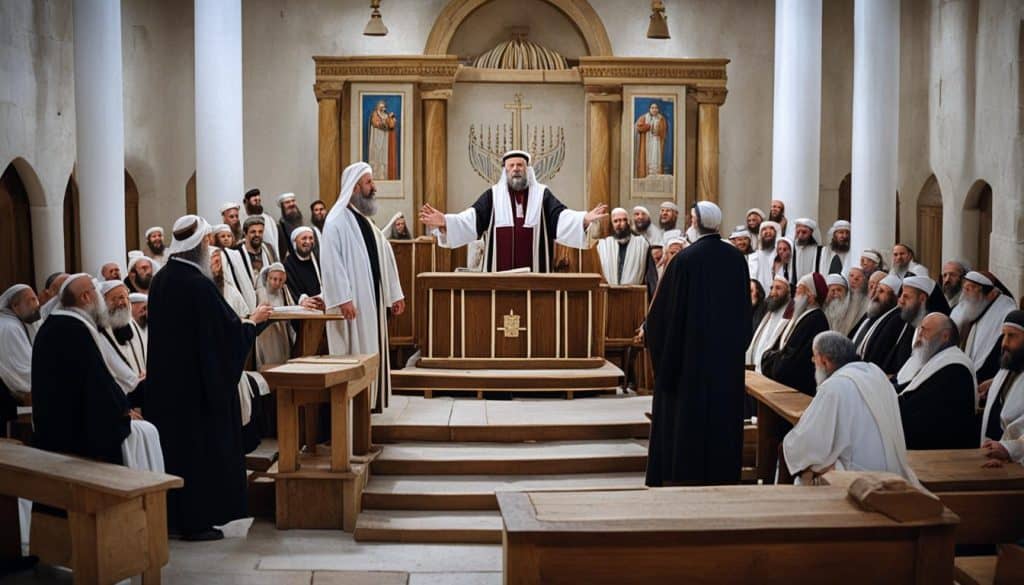
What Events Took Place in the Palatial Gardens Mentioned in the Bible?
The palatial gardens in Bible are said to have been in the ancient city of Babylon, where King Nebuchadnezzar created the Hanging Gardens, one of the Seven Wonders of the Ancient World. Some scholars debate the existence of these gardens, but they are often cited in historical and biblical texts.
King Ahasuerus’ Palace – Where Mordecai Was Honored
In the magnificent halls of King Ahasuerus’ Palace, a remarkable event took place that showcased the unpredictable turns of fate. Mordecai, the wise uncle of Queen Esther, found himself at the center of attention after thwarting an assassination plot against the king.
Imagine the scene as Mordecai, dressed in royal robes, rode proudly on a horse that the king himself had ridden. The grandeur of the palace echoed with echoes of admiration and gratitude for Mordecai’s heroic actions. What could have been a grave situation turned into an unexpected celebration of honor and recognition.
In this twist of fate, the grand hall of King Ahasuerus’ Palace became the stage for a surprise party where the guest of honor initially anticipated trouble but was instead showered with admiration. This moment served as a reminder that bravery and loyalty can alter the course of destinies and transform adversity into triumph.


